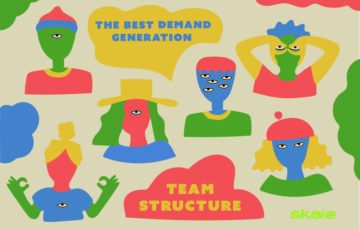
The Best Demand Generation Team Structure to Nurture Leads
So you know you need a demand generation team, now what? Read on for the people you'll need, their skillsets, and what you should be paying them.
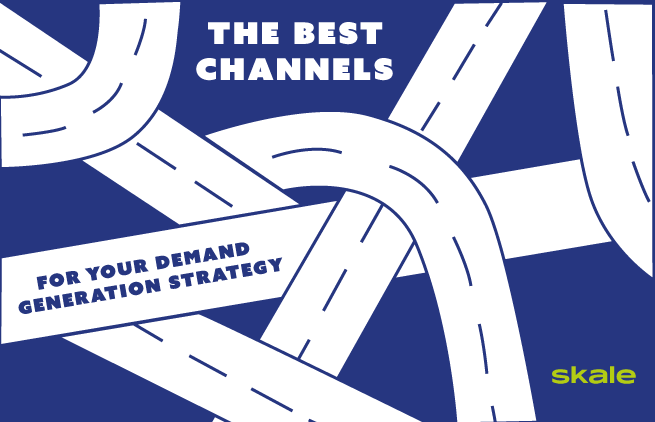
Demand generation today is paramount to getting the leads and customers your business truly deserves.
“It’s all about figuring out which breadcrumbs drive the horse–your customer–to water–your product–and then make him drink.“
—Paige Arnof-Fenn, founder and CEO of Maven & Moguls
The channels you use in your strategy can make or break your whole growth plan. Not all B2B products will use the same channels in the same way, nor will they work with all products.
Choosing the right demand gen channel for your strategy is no easy task–no fret, we’re here to breadcrumb your journey. In this article, we’ll cover:
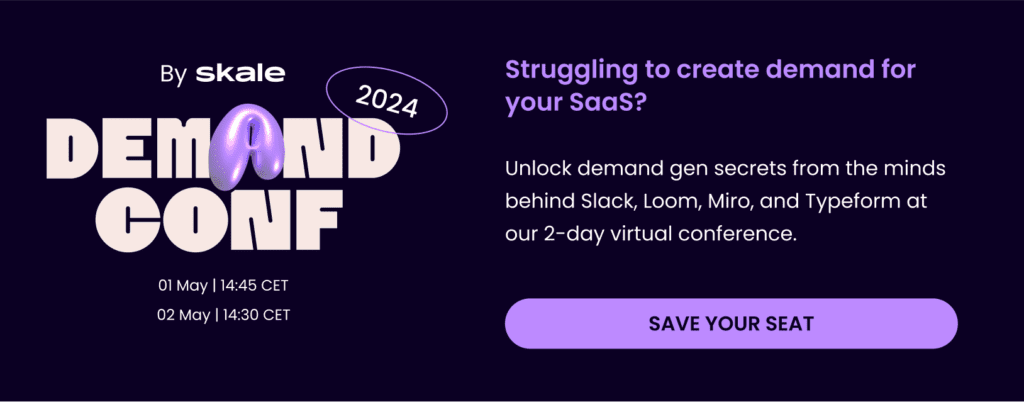
To properly understand what B2B demand generation is, we need to acknowledge the power that customers have over their own buyer’s journey. It’s the act of pulling customers to you, via a pathway that feels natural and familiar to them.
Customers can find all the information they need to decide whether or not to make a purchase, even before ever speaking to a sales rep or being bombarded by ads.
Today, sales teams only have about 5% of the customer’s time on their B2B buying journey. It’s this empowering position that customers have that has changed the way brands advertise and make themselves stand out.
Marketing teams are now being challenged by self-taught customers, and by customers’ higher expectations of products–thanks to the wide variety available–and businesses’ higher-performance needs–thanks to all the metrics available.
Marketing and sales teams need to work in sync and genuinely understand their customer and market in order to create a successful demand generation strategy.
Demand generation and lead generation marketing are two different strategies. However, people tend to use these terms interchangeably at times–but they are completely different.
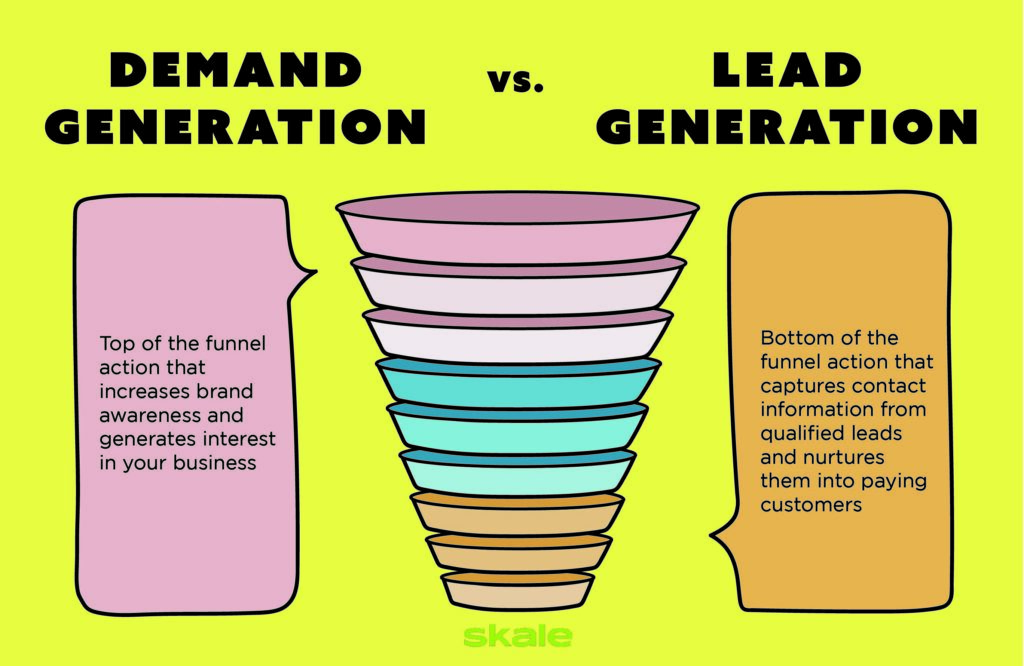
Demand generation marketing is the process that focuses on meeting possible customers at the very top of the sales funnel. Demand generation campaigns increase brand awareness, educate audiences, and generate trust.
Lead generation marketing focuses much more on the bottom of the funnel. Lead generation marketing mainly consists of creating lead magnets–think gated content or freebies that you give in exchange for an email account. This will help you collect a visitor’s contact information–and then you’ll nurture this lead through–you guessed it–lead nurturing.
However, obtaining a bunch of leads will be pointless if you’re not truly working on your demand generation. A faulty demand generation, that sits at the top of the funnel, will bring you low-quality leads and will make your lead nurturing a harder job than it should be. That’s why here at Skale we focus more on demand generation–a strategy that will actually attract the right profiles to your services and the high-quality leads you’ll then be able to turn into customers in a heartbeat.
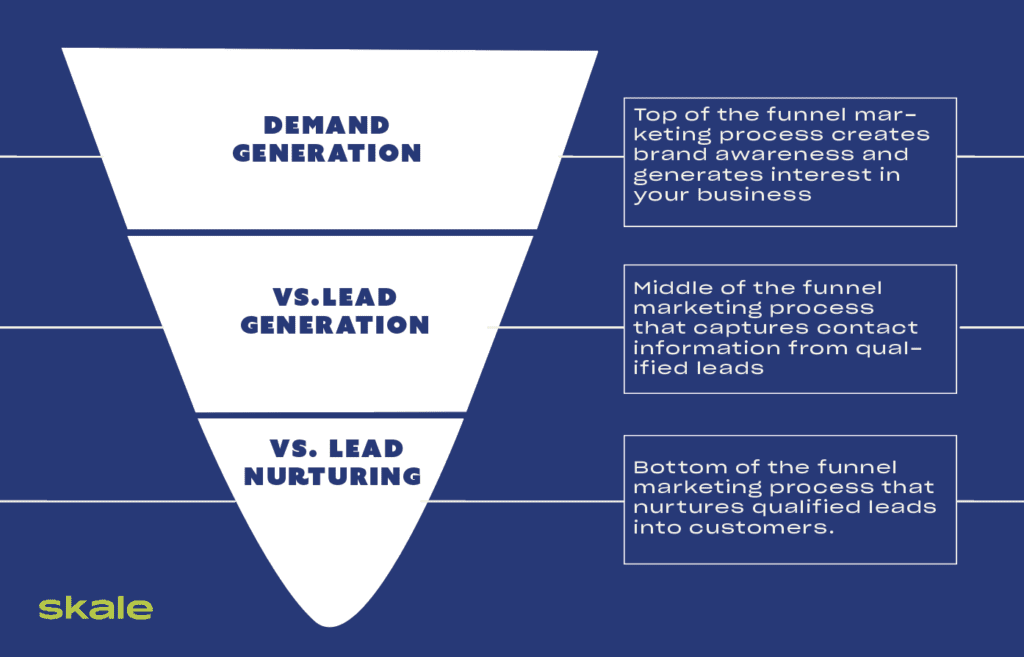
To develop a successful demand generation strategy, you’ll need your sales and marketing teams to follow these eight demand gen best practices, which are:
However, a fundamental part of any demand generation strategy is the channels you’ll use. Below we’ll tell you the best demand gen channels to get the high-quality leads and conversion rates your business deserves.
There are many demand generation channels available, take a look at the example below, but here we’ll tell you about the top seven channels that marketers are using to guarantee results.
First, let’s cover the top seven demand gen channels you need to know to get your business to a new level. After, we’ll show you how you can choose the one that best fits your business and market.
Thought leadership content is authoritative, positioned at the top of the sales funnel and it’s designed to establish your company as an expert in your industry.
Since demand generation is all about increasing brand awareness and credibility, one of the best ways to do this is by providing thought leadership content.
Paige Paige Arnof-Fenn, Founder & CEO of Mavens & Moguls, started a global branding and digital marketing firm 20 years ago and she says that one of the best ways to generate demand is through thought leadership:
“This is a great way to build your brand, increase your visibility more broadly, raise your profile and attract more clients. Activities like speaking at a conference, writing articles, and building your following on social media all contribute to increasing your awareness with potential customers and building your credibility with a larger community. Instead of trying to start your own blog or newsletter, try contributing regularly to existing well-trafficked blogs in your industry or newsletters of like-minded organizations reaching the same target audience as you.“
Showing that you’re an expert on the topic and that you really understand your customer’s pain points is the first step for customers to trust you and pay more attention to what you can offer them.
SEO is a key tool to place your content where it deserves to be. By paying attention to the on-page SEO elements such as keywords and content length, and off-page and technical SEO aspects such as internal linking structure, you’ll make sure your expert knowledge is located where your potential customers are looking and clicking.
“SEO is not something that can be gamified anymore and with the influx of AI technology creating content effortlessly, it is more important than ever to develop blog articles for SEO that have perspective and experience that an AI can’t replicate. This is where first-party data and case studies can be really effective as they are unique to your business.”
–Dan Gray, CEO at Vendry

Rezi did- that’s why they chose to work with us, increasing their revenue by 176% in just four months
See how we did it
Webinars are a great way to directly engage with your target audience. They allow you to show your expertise while putting a face behind the logo.
Webinars are not hour-long sales pitches. A webinar is to showcase your knowledge and interact with potential users.
Choosing the topic for the webinar is super important. One way you can find what your potential customers are interested in is by looking at your other channels. For example, if a post on social media, or on your blog, had really high engagement or even a lot of questions and comments from users, this might be a great indicator that you can build a webinar on the topic.
Another great way to implement webinars for demand generation is by addressing your audiences’ pain points and by explaining how your product or service works to address those same pain points. For example, do a step-by-step webinar where you explain to your ICPs how to solve a specific pain point with your tool. This will not only make them trust you more because you’re being open about your product but will also tip the scale for them to get your product since they already know how to use it.
If you’re ever unsure about topics, just ask your audience! Use a tool like 123FormBuilder to automate your customer feedback, and build your topics for the webinars.
Keep in mind the person or people that will present the webinar. You want to choose someone who is approachable, knowledgeable, charismatic, and that represents your brand’s voice.
Emails are still great ways to engage with customers. However, it needs to be with people that already know your brand and the content of the emails needs to be genuinely valuable. People love emails–53% of marketers say it’s the most effective channel for demand gen–but they hate spam–keep that in mind.
When creating your email campaigns you’ll need to keep three principles in mind:
Frequency: it doesn’t matter how valuable your content is, if you keep bombarding your clients with too many emails they will start seeing them as spam. In the same breath, if you start emailing too sparingly, customers will forget about you and your email marketing will lose its momentum.
Segmentation: helps keep your emails relevant. If you target each email to a specific type of customer, by industry, position, interaction, or any other demographic, it will help you deliver tailored, valuable content.
Implementing clear calls-to-action and next steps in your emails allows your potential customer to get the most out of the email. Make it easy for them to find out more about your brand or your products.
When using emails for demand generation your main focus will be on creating demand for other products that you sell. This means product launch emails or invitations for webinars about other pain problems–and their solutions with your products–that your customers have.
Additionally, it’s important to seize technology’s full potential for your email campaigns. Janelle Amos, Founder & Demand Gen Consultant at Elevate Growth, likes to focus on trigger-based campaigns. For her, these campaigns are better since they allow the customer to tell you where they are in the journey and you can feed them exactly what they need to keep moving down the funnel. Thankfully, there are plenty of software and tools out there that help you with automating these campaigns and seeing the impact they are having on your potential customers so you can course-correct when needed.
💡 Top tip: Userlist is an email automation software specially designed for B2B SaaS companies.
Lastly, Janelle also mentions the importance of following a zero-click style of email in your newsletters. Zero-click is a term used for content that allows the user to stay on the platform instead of clicking a CTA and being redirected to another site. For example, a post on Twitter will give a fact or interesting copy and then have the reader click on the CTA to go on to a blog post, landing page, or another platform. However, when it comes to emails for demand generation, it can be better to provide all the information the user needs right there in the email, this will improve the chances of them actually reading your email and slowly build your thought leadership.
“I’ve taken a different approach to use newsletters to establish brand credibility and brand trust by creating a hot topic every single week or every single month, or whatever cadence you send your newsletter for, and using that where it has actionable tips, FAQs, Q&As, infographics, and more. However, I like to make it zero-click, where if they did nothing else but read this email they’ll have everything they need. They don’t have to just bypass the promo copy of ‘download this guide’ or ‘click here to go learn more’.”
Janelle Amos
Once you have a potential–or already–customer email address, use it wisely and you can see your ROI and profits increase.
Podcasts have become one of the primary ways for people to learn new things. In fact, 74% of podcast users listen to them to learn something new. Podcasts have become a popular way to look for entertainment and knowledge.
More than half of Americans do chores while listening to podcasts, and users spend an average of 6 hours and 37 minutes listening to podcasts every week.
With all of this engagement and popularity, it’s a big miss to pass on being part of the podcasting ecosystem. In fact, according to a BBC-commissioned report, companies that have podcasts saw an increase in:
Podcasting has become even more important for B2B brands in the last few years, so much so that there’s a new term for it: ABP, or account-based podcasting. This means including your podcast in your account-based marketing strategy and actually having it as your main piece of content that will get to that highly-specific audience of potential customers.
Podcasts are a great way to connect with your audience and improve your brand awareness and loyalty. Whether your product is a travel management tool or you offer content writing services, or any other B2B business, you’ll be wise to start a podcast.
However, it’s important to point out that podcasts are not easy. On one hand, users can listen to podcasts wherever and whenever which is great because you won’t be competing with other channels that require the user to be fully present and engaged. On the other hand, you’ll be competing against the thousands–if not millions–of other podcasts out there in the selection process.
How can you make their selection process easier? Well, collaboration is a great way to get new eyes–and ears–to your podcast. Like Riaz Kanani, founder, and CEO at Radiate B2B, said to us:
“With more marketing activity happening outside your website, collaborations are incredibly important. Building your own audience remains important as it gives you a foundation to build out all your activities from, but waiting for your audience to sign up is often too late–as by that time, your competitors will already have been engaging and influencing them. We collaborate with influencers and thought leaders and co-promote on our LinkedIn Live as well as guest appearances on their podcasts to reach a wider audience. This in turn increases our audience but also allows you to reach a much wider audience than you would otherwise be able to do.”
Another great way to improve your demand generation campaigns is to go on social media. However, we don’t mean Instagram or Facebook. No. We mean the social media platform that is all the rage for B2B companies: LinkedIn.
“LinkedIn has become more than an online resume or Rolodex, it is the foundation for building trusted relationships in the digital economy.”
–Paige Arnof-Fenn
According to LinkedIn, 90% of B2B marketers use LinkedIn Ads and organic traffic to achieve their B2B marketing goals. With more than 130 million users actively using the platform every day–and with a cost per lead 28% cheaper than Google Ads–you know you can’t go wrong with LinkedIn.
Janelle Amos, says the most important thing to keep in mind for LinkedIn Ads is to make them content and buyer-first:
“The first channel I love for demand generation is having quality LinkedIn ads. For B2B, the potential buyer consumes and engages on LinkedIn, that’s for certain. So I focus on really having that content-first approach and getting those levels of engagement from the audience. By supplying a content-first and a buyer-first mentality on LinkedIn ads you’ll see your DMs and the traffic to the website increase. A real-winning strategy.”
Janelle Amos
Additionally, demand generation experts like to not only use LinkedIn for its ads but to build their expert reputation. Paige Arnof-Fenn says it great:
“To present yourself as an expert in your industry post interesting and educational content by sharing a great article you’ve read recently or if you truly want to make valuable connections and represent yourself as a talented thought leader in your industry, you should be crafting your own articles on LinkedIn.”
Lastly, here’s how Riaz Kanani uses podcasting and LinkedIn to increase his thought leadership and overall content marketing performance:
“We run a LinkedIn Live series called ThinkHuman which we then repurpose for podcast distribution. While most B2B LinkedIn Live content is gated, we do not gate this series and instead focus on using it to increase awareness and interest within our target market. This regularly drives 1000-2000 people to be exposed to the series. The content focus is much broader than our offering but focuses on pain points our target persona is having. These pain points sometimes are directly relatable to our offering and sometimes not, allowing us to build an audience that reaches beyond those directly in need today, but who are likely to have a need tomorrow.
Because the content is delivered via LinkedIn, we do see around 20% of the profiles of people watching which in turn allows us to invite to follow-up events, growing our audience over time.
The content also serves to power our content marketing – across social, website, and email as we move companies through the sales funnel.”
💡Top tip: Use the Pinpoint Technique to increase your LinkedIn Ads’ ROI. It essentially allows you to use LinkedIn’s massive store of B2B data to send ads to the exact person you want to read, not just a general audience that fits a box.
Pay-Per-Click (PPC) and Search Engine Marketing (SEM) are two of the most-used channels by B2B SaaS companies.
The main advantage they offer is that the results are seen immediately. Additionally, PPC spending is easy to track and gives straight results and ROI. However, because you have to pay for each click on your Google Ads, this means that the customer acquisition cost is typically high.
As Paige Arnof-Fenn shared with us:
“Using organic SEO and PPC together is ideal now as main search engines are constantly changing their algorithms for rankings so stop thinking of SEO and PPC as rival forces. When used together they are complementary services that help boost your marketing strategy and increase brand exposure.
Building brand awareness and trust in your brand/business begins by getting your business name to appear in prospects’ searches. Seeing your brand name appear twice, both on organic and on paid results creates more brand awareness and intensifies your business’s trustworthiness.
Research shows that if two brands have the same products, people will be more likely to choose the one they are familiar with. When a brand is shown in organic results alone it only gets 60% of clicks, whereas a brand that appeared in both organic and paid search results, attracts 92% of total clicks. When paid listings are shown beside organic, the click-through rate of paid ads increases. This means that clicks increase for both organic and paid listings when they are both featured and do not detract from each other.”
Additionally, here’s what Luke Genoyer, Head of Business Development at Global Call Forwarding advice when it comes to PPC:
Demand generation aims to increase awareness and reach in order to increase high-quality leads that will then be turned into customers by the lead gen strategy. Account-based marketing is one of the best ways to ensure demand, leads, and customer acquisition. Why? Because it focuses so much on a specific account and personalizes all marketing efforts to perfectly match the account targeted.
Riaz Kanani shared a lot of his ABM wisdom with us:
“ABM is an excellent strategy that when scaled can become the default way of building pipeline using a demand generation approach. Many start with ABM in its most focused form, however targeting one company at a time or a small cluster of 10-20 can work when you have a lot of insight into each company. For example, upselling to existing customers. But it can be expensive without that knowledge upfront. Instead, it is better to target a larger set of companies with a similar need and then invest in those showing some form of engagement or intent. You can then continue to scale this approach to different sets of companies with different needs, or as companies move further through the pipeline tailor the messaging further to accelerate closing the contract.”
“Instead, we use account-based advertising to create a group of companies that are directly targetable and this allows you to build significant awareness without a large investment in media spend. This then gets powered by intent data so you are constantly able to drip advertising in front of companies showing an interest in topics you care about. Alongside this, we run LinkedIn Live which both drives thought leadership and positioning within the industry, but also powers social media content, email nurture, and sales messaging.”
💡 Top tip: Focus on what you already know, this means, talking to sales and finding out who is your ideal customer. Which type of customer do you fit better with? Who are you providing better results to? Once you know that, you’ll know which companies you’ll want to target in your ABMs efforts.
Sweet Fish’s B2B Growth interview with Greg Batchelor, vice president of growth marketing at Platform.sh, shines a light on one of the most important pieces of advice people can hear when it comes to ABM: to be laser-focused.
Once you understand who the companies you want to target are you’ll need to be laser-focused on your messaging across all channels to them. You’ll want to really answer any questions they might have and focus on only their pain points. This is what account-based marketing is all about, is about going specific on who you’re targeting.
There are plenty more channels to consider, but these are the main channels that we know will help you generate the demand of your dreams!
Natalia Brzezinska, Marketing & Outreach Manager at PhotoAid, points out:
“There are a variety of demand generation channels that businesses can use to reach their target audiences. The most effective channels will vary depending on the type of business, product or service being offered, and the target market.“
It’s true that finding the right channel for your specific situation in terms of products, target audience, and industry is no easy task. In fact, Kevin Barry, co-founder at Right Percent, says that the first thing to note when it comes to demand generation is that “finding product-channel fit is hard!“
We’ve been warned of how hard it really is, yet we must still do it and be meticulous when trying to choose the right channel. When it comes to demand generation, it really is the crux of the matter.
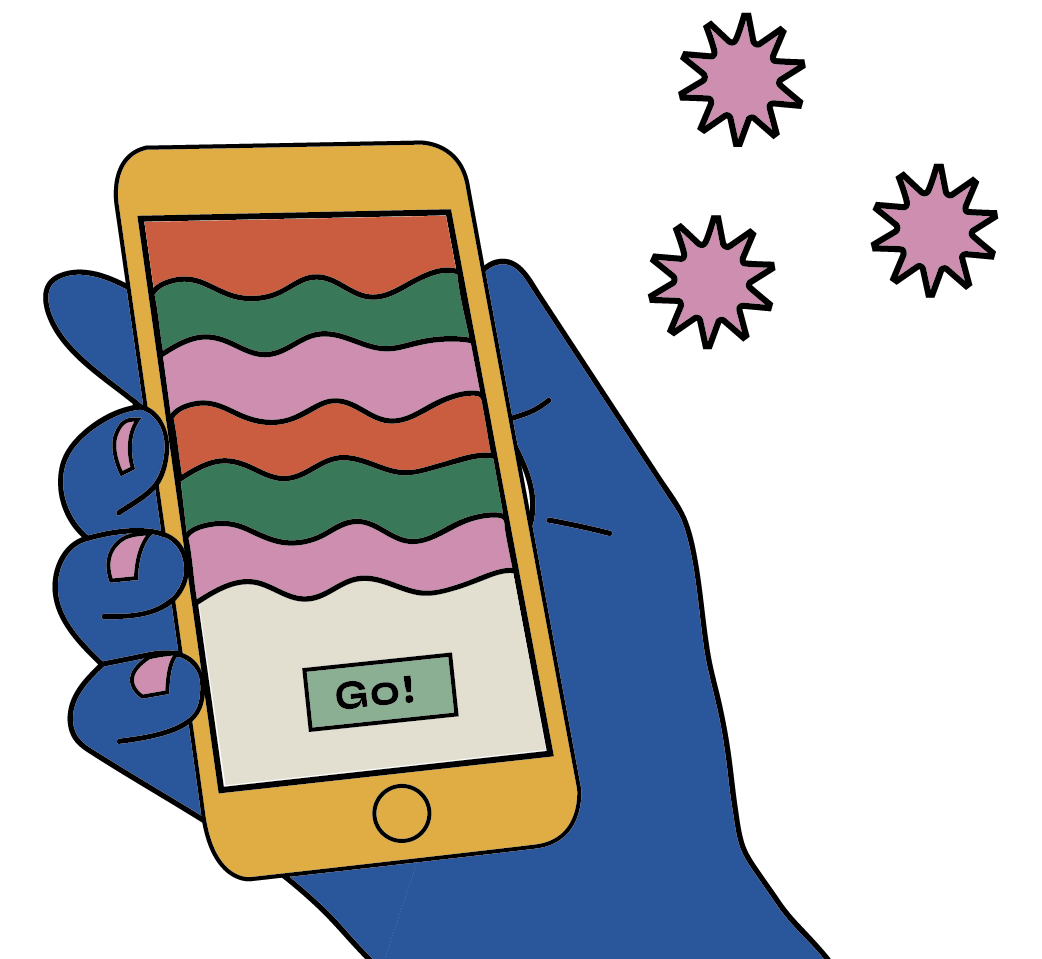
So did our clients- that’s why we created our experience-driven guide to a CAC-reducing demand gen process
Read the guideThings to keep in mind when choosing your demand gen channels:
The first thing you need to do is deeply understand your market. Use all the data collected, and that you can find from other companies, to really narrow down who your audience is. What do they like, where are they, and what their pain points are?
“When you analyze your market, you determine whether you can go for blogging, direct mailing, social media, PR campaigns, or influencer marketing. You may also create webinars, videos, or podcasts, write e-books, or organize live events. […] Just remember to balance your scale and personalization in the right way.”
– Nina Pączka, Community Manager at Zety.
Source: Provided by Kevin Barry
Of course, your aim is to generate demand, however, think about the greater purpose. If you want to increase your sales fast, improve your brand reputation and credibility, or establish a solid community, your go-to channel will change.
Once your demand generation strategy is up and running, you’ll need to constantly check how it’s going. There are plenty of demand gen metrics available for you to use and analyze, but here are some of the most used:
Lastly, don’t forget that you aren’t constrained to using only one channel. Metric charts analyzed the B2B market shares by the number of sales channels used and the results are what you would expect: the more channels that were used, the better.
However, not all companies will have unlimited time and financial resources to use as many channels as they wish, but this is a great reminder to not narrowly focus on only one channel.
Let us know how you get on with these demand gen channels and thanks for reading!
Demand generation channels are the platforms and channels that marketing teams focus on to reach the target audience. Although demand gen is located towards the top of the funnel, the different channels available will target a specific area in the funnel, which is why it is paramount to know why each channel is used.
Examples of demand gen channels include: PPC/SEM, social media, webinars, thought leadership, and content marketing.
Depending on the channel that you implement for your demand generation strategy the content will vary. Brand awareness content will be different from thought leadership content, or a PPC piece of content.
To create a winning demand generation plan you need to understand your target audience, your industry, and market, and how each demand generation channel plays a role.
Once you figure this out you’ll need to align your goals, with your budget, and start creating a strategy. Once the strategy is up and running you’ll need to constantly check on it and analyze the data you’re obtaining to see where changes need to be made.
Learn more about
Demand Gen

The Best Demand Generation Team Structure to Nurture Leads
So you know you need a demand generation team, now what? Read on for the people you'll need, their skillsets, and what you should be paying them.
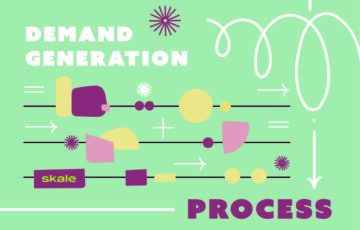
6 Elements to Include in your Demand Generation Process
Everything you need to know to build a stellar demand generation process, and a more profitable SaaS business.
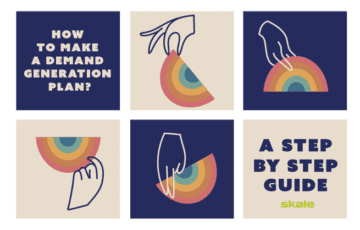
How to Craft a Winning Demand Generation Plan
Your eight-step guide to crafting a demand generation plan that helps your SaaS take flight.